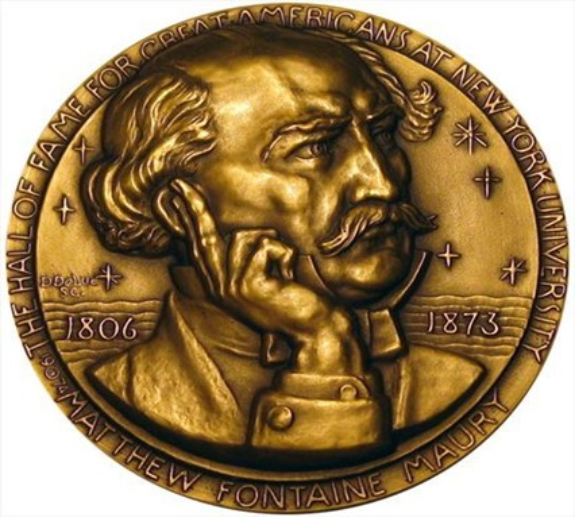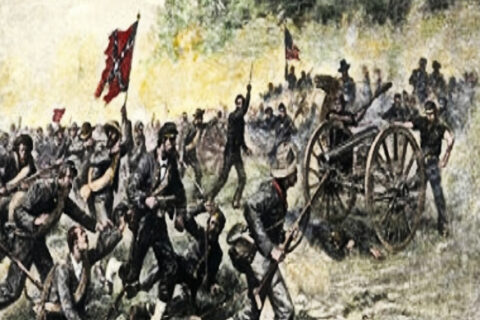(Note to readers: Below is Chapter IX of my book, The Life and Times of Matthew Fontaine Maury, Pathfinder of the Seas. Ten additional chapters of the book have been published here at Identity Dixie to date, and may be found throughout my contributor pages, beginning here.)
Superintendent of the Navy’s Depot of Charts and Instruments was not an especially coveted position for a naval officer of lieutenant Maury’s qualifications, and there was some expression of dissatisfaction with the appointment on his behalf from many of his friends, as well as a number of his relatives. But Matt was satisfied with the new position and accepted the appointment without hesitation or mental reservation. Truth told, he was just relieved to be back in active service following the long layoff resulting from the debilitating injuries he’d suffered from the unfortunate coach accident two years before. Whether he was overqualified or not was of little concern to Matt; he fully intended to make the most of the new post no matter what.
As a naval officer in his seventeenth year of service, Matt was very much aware of the existence of the Depot of Charts and Instruments, and, accordingly, sufficiently familiar with the nature of that office’s operations. Indeed, he had sought the assistance of the depot’s staff in his attempts at determining the fastest route to Rio de Janeiro as sailing master of the Falmouth some eleven years before in 1831. So, in addition to his passing knowledge of that office and its operations, he had direct experience with the depot as well. During the intervening years between that appointment and now, operations at the Depot had certainly improved in certain respects and to a degree beneficial to the Navy and its overall effectiveness, but Matt believed the institution had yet to fulfill the hundredth part of its full potential if only its management were to be placed under guidance of the right man and a new and better system. Matt truly believed he was the right man for the job, with the right system needed to transform the depot from one of very limited means and effectiveness, to one that would become the envy of leading maritime nations the world over.
In addition to its inventory of charts and instruments, the Depot was also home to an extensive and ever-growing collection of old ships’ log books dating back twenty, thirty, even as much as forty years. No one previously under the employ of the depot had ever known quite what to do with these old ships’ logs; it had become the habit of the officers there to store them away, unopened and unread, in an unused room in the basement of the facility, out of sight and out of mind. And this practice was kept up until shortly after Matt took over command of the Depot.

These old dust covered log books were certainly out of sight and out of mind. But upon surveying his new offices, Matt soon discovered the room in which they were housed and was intrigued by its curious contents. The junior staff officers who had stayed on when he took the reins at the Depot confidently assured lieutenant Maury that these dusty old log books were of little to no value to the Navy, and confided in him that they had always considered them a nuisance and had recommended before that they be discarded or thrown away to free up much needed space. But Matt wasn’t so sure.
During the first few weeks of his command at the new post, Matt would begin rummaging through the pages of the old ship’s logs one by one, and he soon began to realize that his new position had inadvertently landed him atop a Scientific Mariner’s gold mine. Although there was no uniform or systematic way in which the entries were made, and no two logs were therefore very much alike between covers, virtually all of them nonetheless contained very useful and valuable information on winds and currents at sea along the courses of various routes to scores of ports, and during all seasons of the year. Many of them also contained barometer readings, as well as entries noting compass variations along their routes. These entries were the “gold” awaiting discovery in the “mine” that was a damp room in the basement of the Navy Depot of Charts and Instruments.
Instantly a plan began to formulate in Matt’s active mind of how to extract the scientific information from these old, long-forgotten dust collectors and to organize it in such a way so as to make it most beneficial to American seamen on their future voyages to and from faraway ports. One thing was certain: in the state in which he found it, this large collection of old sea logs had heretofore served no useful purpose, and had indeed been needlessly taking up valuable space at the depot that might otherwise have been put to better use. The general attitude among his staff concerning the logs was therefore understandable, Matt thought, although he believed this attitude was more attributable to a fault of the head than of the heart. It therefore became his first goal to correct this attitude among the staff officers under his charge.
Once he had worked out the details of a satisfactory plan for resurrecting the old sea logs from the dust bin, lieutenant Maury called a staff meeting and explained to his officers what he had discovered “hidden in plain sight” in the old ships’ logs, and his general plan for systematizing and making the information useful to seafaring men in the future. His plan, which he hoped aloud they would lend their cheerful assistance in putting into immediate operation, was that each staff officer would be assigned one log book, and would spend a portion of his work day pouring through its contents, extracting from its pages entries on wind direction and speed, current direction and strength, temperature and barometer readings, compass deviations and so forth; he would make notations of the exact coordinates at which these readings were taken, as well as of the time and date, and make a notation, for future consideration, of any additional information he considered to be potentially valuable. Once the officer had extracted all the useful information from his assigned log book, then it would be indexed and filed away in an orderly fashion and the officer in question would then be assigned another log from the collection, with which he would repeat the process. As there were hundreds of log books stowed away in the basement, and as each of them contained hundreds and even thousands of such entries, lieutenant Maury explained that their work would be difficult and tedious, and would perhaps take years to complete. But he assured them that the benefits would far outweigh the costs of their labors when their work was finally done.
The officers on staff quickly came to understand the great and untold value of the work lieutenant Maury was proposing, and they each pledged to him, and to one another, that they were on board with the plan one hundred percent and would move mountains, if need be, to see the great and noble work through to its completion. Right away these young officers knew that lieutenant Maury was a very different kind of a “chief” under whose supervision they had ever before worked, in that office or elsewhere. And straightaway they set about their new work with a keen sense of direction, of pride, and of absolute unanimity of purpose, the likes of which none of them had ever experienced before.

When news got out that H.W.D.C. Wright had smashed the average sailing time to and from Rio by following lieutenant Maury’s sailing directions, ship masters and captains from all over the country began to clamor for their own copies of Maury’s charts and sailing directions. By 1843, just one year after Maury and his staff began the tedious work of organizing the scientific data simultaneously being extracted from the old log books, enough progress had already been made in the project for Maury to write and publish a scientific paper on the subject. The publication of this paper would arouse general interest in the project while Maury and his staff continued to pour through the old log books at their disposal as quickly and efficiently as unavoidable constraints on their time by the imposition of other duties would allow.
Meanwhile, the difficulty of their labors did not dissuade Maury’s staff; to the contrary, each member of the team had already begun to realize that their work was producing beneficial results that before none of them, except lieutenant Maury himself, had ever dreamed of. The practical realization of those benefits to the broader seafaring world would not come until some years later, but all hands knew by now that they would definitely come. Work on the project was fast becoming a “labor of love” for most of Maury’s staff, and everyone seemed now to come to work every day with a renewed sense of purpose, eager to advance the project forward, and to learn in the process what new and valuable insight or discovery the new day might bring.
Four more years would pass before enough data would be collected and organized for lieutenant Maury to publish his first Winds and Currents Chart of the North Atlantic, as that map would come to be called. All of the information for which had been extracted from the “quarry” of old ships’ logs stored in the basement at the depot. Shortly following the success of H.W.D.C. Wright in reducing the average sailing distance to and from Rio by more than a month of days, Maury would capitalize on the new interest in his work by making available for issue, to all who should apply, his Abstract Log for the Use of American Navigators. But in order to achieve the greatest benefit in the least time and at the least expense, he would need to obtain permission from the Navy to make his Winds and Currents Chart available to private merchant vessels as well, free of charge to their captains, on the condition that they agree to cooperate in the scheme by collecting data on their voyages, to be entered several times daily into the Abstract Log, and to turn the log over to the Depot once back at home port.
The idea of the Abstract Log was something Maury had conceived years before, but it would only be useful in his scheme if and when the log were issued to hundreds of vessels sailing for scores of foreign ports and back at any given time of the year. The more of the Logs that were issued, the better. If the cooperation of hundreds of ships captains could be obtained in collecting and furnishing the data Maury sought, and all according to the singular plan systematized in the Abstract Log, then and only then might the real work begin of making and providing highly reliable charts of winds and currents at sea, and of printing recommended sailing directions to and from scores of ports during all seasons of the year. This would be the realization of the vision lieutenant Maury’s imagination had formed from the moment the idea of the Abstract Log came into his head during that memorable voyage on the Falmouth more than a decade before.
With the success of H.W.D.C. Wright in proving the practicality of following lieutenant Maury’s sailing directions and Winds and Currents Chart, came the opportunity to put the Abstract Log to broad and practical use. These events would usher in a new dawn in the history of maritime navigation; they would bring honor and respect to the U.S. Navy, and would make the name Matthew Fontaine Maury among the most recognizable in the world for many decades to come.






